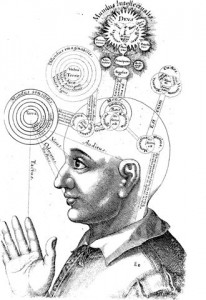
One afternoon at the end of freshman year of college, I got called into the President’s Office where an icy administrator confronted me about a food fight that my friends and I had been planning over email. He knew everything.
I was more frightened by the idea that they’d stripped this information from my email than I was about any of the “serious consequences” I’d suffer if the food fight happened.
That was 12 years ago. That Big Brother has access to our electronic communication is, sadly, fact. Next up, mind reading.
In science fiction and fantasy, not all mind-reading is the same.
Sookie Stackhouse struggles to actively shut out the mind chatter of those around her. In Inception, dreams can be raided for information. In Babylon 5, telepaths can gain access to thoughts, feelings, and memories by performing a mind scan.
Sookie was born that way, as a result of supernatural rather than technological powers. Neuroscientists can monitor brain scans of sleeping patients, though no existing technology provides access to the dreams, or entrance into them.
But getting inside our waking minds is another story.
Researchers were able to reconstruct images from subjects’ brain activity, essentially reproducing what the subjects had seen moments before.
Researchers carefully monitored brain activity in 1,000 spots of the visual cortex as subjects watched hours of movie trailers. The researchers essentially figured out which images in the clip corresponded to brain activity in specific areas.
From this, they made a computer program that can translate images to parts of the brain. They increased the translator’s bank of images by running 18 millions seconds of video through the program.
Then, the test subjects watched a new series of images. The computer selected the 100 images in its bank that would produce brain activity that corresponded most closely to brain activity of the subjects as they watched these new images.
The computer’s clips are pretty blurry, given that this is a test of concept, but some images are dead on, and the others are the right size, shape, and color.
If a computer’s database held billions of images, or perhaps an ever-increasing number of images as recorded from the outside world, then theoretically it could perfectly reproduce what someone saw.
Just as Talia on Babylon 5 plays back someone else’s memory in order to look for a murderer, it could be possible to capture images, which might or might not be actual memories, from someone’s brain. The polygraph is still struggling for credibility, so it’ll probably be a while before anyone could use a reproduction of our brain images against us–at least, in court.
Capturing images is different than capturing thoughts and feelings, and it’s a good thing. If an image of Voldemort makes you think of your boss, or an image of an egg makes you think of how you blew up the microwave and lied about it afterwards, you’re safe. For now. Until someone invents the mind probe.
